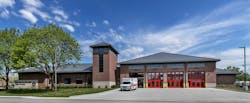Several years ago, town officials and city managers were asking why fire stations couldn’t be built for less than $500,000.
At the 2022 Station Design Conference, fire chiefs, city managers, and others learned why it could be difficult to build a fire station for less than $1 million. It’s not unexpected and even community members do not understand the increasing costs to build a new fire station or public safety facility.
Every year, when the Station Design Award entries are published in the November issue of Firehouse, we hear from several rural departments who have spent less than $500,000 to build a new station. To keep costs down, rural fire departments frequently opt for manufactured structures or pole barns and often rely on their own skilled volunteers to help build out their new stations, and frequently, without any revenue base.
The costs to build a new fire station are based on four areas: location, construction costs, and response services and call volume.
Since the start of COVID, shortages and costs have significantly increased across America. Labor shortages, particularly of trained construction workers, have resulted in delays in most station projects.
A fire chief in a Michigan volunteer department said after the shell of his building was up, the construction firm quit the project for the inability to hire trained employees. Plagued with delays in bay doors and windows, and increased prices for steel and other materials, in final costs, the department was $1 million over budget.
According to Jason Estes, Vice President, Illinois-based FGM Architects shared in the Chicagoland area and much of the Midwest, costs rose normally over the past 2 years. The real increase happened at the beginning of 2022. Wisconsin saw a 25 percent increase from January to June. The Chicago area had a 10-15 percent increase.
Based on their research, Estes explained increases are coming from many factors. “Materials are still going up. Some of this is about availability, and not having enough to support the commercial construction need,” he said. “Labor is another issue. Many trades are down workers. We have found out that Wisconsin has a shortage of masons, which makes it difficult to construct apparatus bays if you are looking for long durability.”
At the 2022 Station Design Conference, Jeff Katz, principal, COAR Design Group, gave a presentation on “Renovate or Build New” and offered the pros and cons of renovating versus new construction. Renovating has definite costs savings, but still is susceptible to increases. California-based Katz is currently working on a couple of fire station renovation projects. “Material availability and labor shortages are both contributing to cost increases as well as delays in completion of buildings,” he said. “Of course, we all see this at the gas station or grocery store too but magnified with building products.”
Architects will agree the cost of building any new house, office or fire station are based on location. Patrick Stone, deputy director of emergency services, H2M architects + engineers emphasized the main cost factor is location.
“Although the function of a fire station may be similar from location to location, they are all unique!” he said. “One size does not fit all… meaning every time a fire station is constructed, it is one of a kind to accommodate that departments SOP’s, apparatus, personnel, administration, culture and more. This means there is no discount for repetition or mass production, and there is certainly cost associated with this.”
Stone shared fire stations are also required to meet or exceed more stringent codes than standard buildings. Defined as “Essential Facilities,” these structures are vital to the socioeconomics of the area they protect and serve. They need to be able to weather the storm. Everything comes with a cost, and these requirements along with hardening of the facility can significantly impact the cost.
Funding is a factor in public safety facilitates and are typically being constructed by way of public funding. Stone said, “In most states, that means there are additional requirements as far as how the building can be constructed. For example, union work or ‘prevailing wages’ may be required. In some cases, apprenticeship programs are included as well. Also, there may be goals to meet MWBE or Veteran Owned business participation.” These are just a few scenarios that can add cost to the project in comparison to a private development that would typically not include these.
Over the past 15 to 20 years, responsibilities for fire departments have grown. While fire calls are down, EMS calls make up over 80 percent of calls for many fire departments. Hazardous material incidents are more frequent and a greater risk to personnel and the community. Numerous and assorted rescue scenarios, response with SWAT teams, and other incidence need not only more certification but advanced training as well. Each of these scenarios require storage space for an extensive variety of equipment in fire stations.
Continued research and heightened awareness on firefighter health and safety have had an impact on station designs. Aside from designated fitness rooms in response to NFPA Standard 1580, statistics reveal significant increases in firefighter cancers. One result was the introduction of the Hot Zone design concept in 2015.
The Hot Zone design, defined as a Red (hot) zone, Yellow (transitional), and Green (living spaces), has quickly been incorporated into new fire stations. Designated ‘dirty’, the red zone requires additional space for decontamination of apparatus, gear, equipment, and personnel.
In addition, architects who specialize in fire and public safety design facilities, believe new buildings will last 60-75 years. Flexibility in design, but also the latest in durable exterior and interior materials add to the longevity of a building, as well as costs.
The most recent trend is the “clean” fire station. According to Fire Chief Richard Mikel, Elk Grove Village, IL, “A clean station is as much a philosophy as it is a physical structure. Personnel need to embrace the idea of keeping contaminants out of their living quarters no matter how the fire station is laid out.”
Elk Grove Village Fire Station 8 won the 2019 Station Design Silver Award. “When our new firehouses were constructed, we fully embraced that clean station concept and built accordingly,” said Mikel. “The ‘dirty side’ of the apparatus bay, which is furthest from the living quarters, is where SCBA cleaning and maintenance, turnout gear extraction, dive equipment maintenance, and even decontamination of personnel, takes place.”
Being proactive in preventive measures for the physical and mental health of firefighters has resulted in additional costs to fire stations. Mikel responds, “Some may say it is excessive, but many of us have dear friends in the fire service who have suffered and/or died from their exposure to the carcinogens we face.”
Fire departments are evolving into full-service centers for emergency services and with that are costs. The 2022 Station Design Awards entries in Firehouse’s November issue will take fire department trends and innovations to yet another new level of services and safety.
About the Author
Janet A. Wilmoth
Special Projects Director
Janet Wilmoth grew up in a family of firefighters in a suburb of Chicago. Wilmoth, who is owner of Wilmoth Associates, worked with Fire Chief magazine for 27 years until it closed in 2013. She currently is the project director for Firehouse, overseeing the Station Design Conference.

